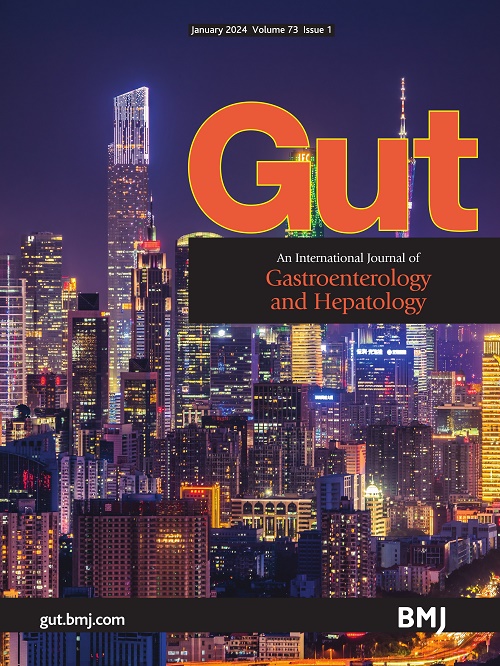Prevention of rebleeding after primary haemostasis using haemostatic powder in non-variceal upper gastrointestinal bleeding: a multicentre randomised controlled trial.
IF 23
1区 医学
Q1 GASTROENTEROLOGY & HEPATOLOGY
引用次数: 0
Abstract
BACKGROUND Non-variceal upper gastrointestinal bleeding (NVUGIB) remains a major cause of morbidity and mortality. Rebleeding rates following endoscopic treatment can reach up to 25% within 72 hours in patients with high-risk lesions. OBJECTIVE To evaluate the efficacy of a haemostatic powder (Nexpowder) in reducing rebleeding rates after conventional endoscopic treatment in patients with NVUGIB. DESIGN This was a prospective, multicentre, randomised controlled trial involving patients with acute NVUGIB from high-risk lesions who achieved initial endoscopic haemostasis. Participants were randomised 1:1 to receive either the haemostatic powder or no further therapy (control group). The primary outcome was the rebleeding rate within 72 hours post-treatment. Secondary outcomes included the 30-day rebleeding rate and the safety profile. RESULTS A total of 341 patients (72.1% male; mean age 64.8 years) were included, with 173 in the powder group and 168 in the control group. Baseline characteristics were similar between groups. Ulcer bleeding was the predominant aetiology (n=317), with Forrest type I bleeding observed in two-thirds of cases. The 72-hour rebleeding rate was significantly lower in the powder group (2.9%, 95% CI 0.9 to 6.6%) compared with the control group (11.3%, 95% CI 6.9 to 17.1%; p =0.005). A significant reduction was also observed in the 30-day cumulative rebleeding rate (7.0% vs 18.8%), with similar findings in the ulcer subgroup for the 3-day rebleeding rate (3.0% vs 12.0%; p =0.004). No adverse events related to the powder application were reported. CONCLUSION The application of Nexpowder following endoscopic haemostasis significantly reduced both early (3 days) and late (30 days) rebleeding rates in patients with NVUGIB, particularly in cases of ulcer-related bleeding. TRIAL REGISTRATION NUMBER NCT04124588.止血粉预防非静脉曲张上消化道出血原发性止血后再出血:一项多中心随机对照试验
背景:非静脉曲张性上消化道出血(NVUGIB)仍然是发病率和死亡率的主要原因。高危病变患者内镜治疗后72小时内再出血率可达25%。目的评价止血粉剂(Nexpowder)在降低NVUGIB患者常规内镜治疗后再出血率方面的疗效。设计:这是一项前瞻性、多中心、随机对照试验,涉及来自高危病变的急性NVUGIB患者,这些患者最初实现了内窥镜止血。参与者按1:1随机分组,接受止血粉或不接受进一步治疗(对照组)。主要观察指标是治疗后72小时内的再出血率。次要结局包括30天再出血率和安全性。结果共341例患者,其中男性72.1%;平均年龄64.8岁,散剂组173例,对照组168例。各组间基线特征相似。溃疡出血是主要的病因(n=317),三分之二的病例观察到Forrest I型出血。粉末组72小时再出血率(2.9%,95% CI 0.9 ~ 6.6%)明显低于对照组(11.3%,95% CI 6.9 ~ 17.1%;p = 0.005)。30天的累计再出血率也显著降低(7.0% vs 18.8%),溃疡亚组的3天再出血率也有类似的发现(3.0% vs 12.0%;p = 0.004)。未报告与粉末应用相关的不良事件。结论内镜止血后应用Nexpowder可显著降低NVUGIB患者早期(3天)和晚期(30天)再出血率,尤其是溃疡相关出血。试验注册号:04124588。
本文章由计算机程序翻译,如有差异,请以英文原文为准。
求助全文
约1分钟内获得全文
求助全文
来源期刊

Gut
医学-胃肠肝病学
CiteScore
45.70
自引率
2.40%
发文量
284
审稿时长
1.5 months
期刊介绍:
Gut is a renowned international journal specializing in gastroenterology and hepatology, known for its high-quality clinical research covering the alimentary tract, liver, biliary tree, and pancreas. It offers authoritative and current coverage across all aspects of gastroenterology and hepatology, featuring articles on emerging disease mechanisms and innovative diagnostic and therapeutic approaches authored by leading experts.
As the flagship journal of BMJ's gastroenterology portfolio, Gut is accompanied by two companion journals: Frontline Gastroenterology, focusing on education and practice-oriented papers, and BMJ Open Gastroenterology for open access original research.
 求助内容:
求助内容: 应助结果提醒方式:
应助结果提醒方式:


